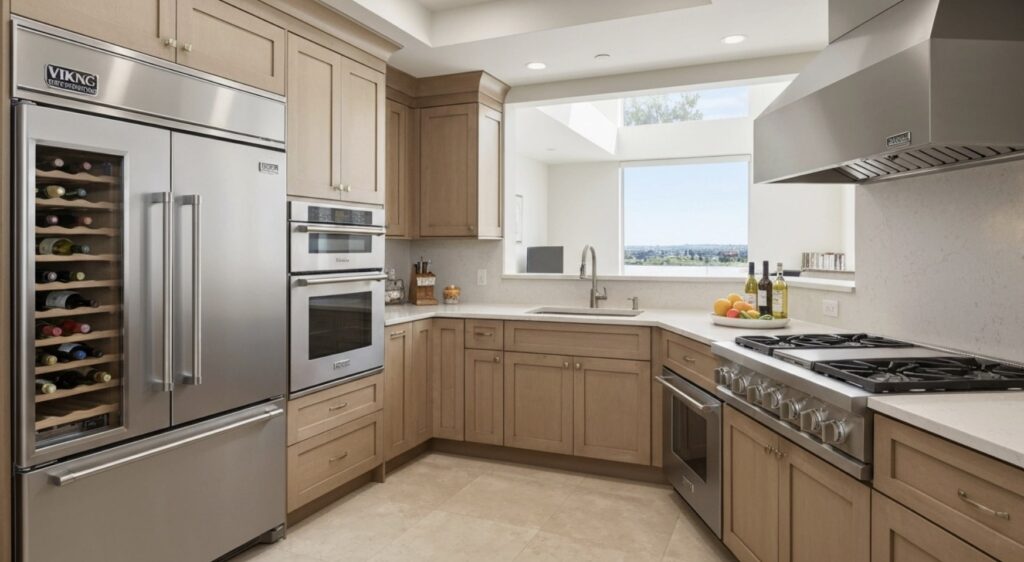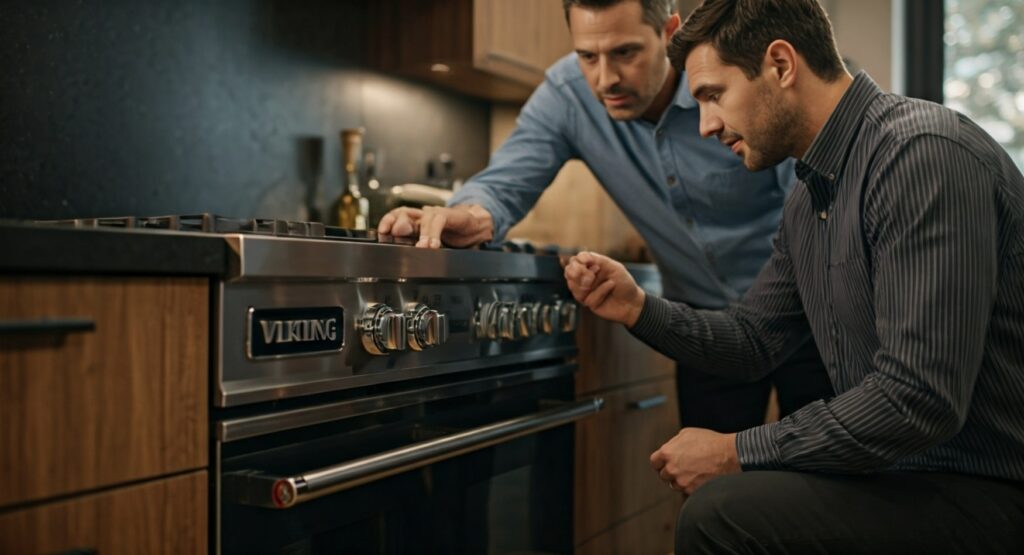When you own a home, it can be stressful when an appliance stops working. Problems like a refrigerator turning off or a washing machine not spinning can mess up your day. You might stop and ask if you should try to fix it yourself or call an appliance repair technician. There are some things to check before calling an appliance repair tech. These steps can save you time, money, and effort. This guide is here to help all homeowners with Viking appliances. It covers some important things to check. These checks can help you choose if you need repair service or if you can do some simple troubleshooting to get your appliance working again.
4 Essential Checks Before Contacting an Appliance Repair Technician
Before you call a repair technician like us at Viking Appliance Repair Pros, take some time to check the appliance yourself. This helps you find small issues. It can save you money and fix things quicker. Look at the Viking appliance’s power connection. Try to understand what the error codes mean. This helps you see what the problem might be.
Also, be sure that the hoses and filters do not have any dirt or blockages. Check if any moving parts are broken or worn out. These easy steps will give you important facts. You can use them to talk with repair pros. If you still need help, the details you gather can make their job faster and easier.
1. Verify the power supply and connections
A broken appliance may not be getting power. People often miss this simple cause. Start by checking if it is plugged in all the way. Vibrations or moving things around can make the plug come loose. Make sure your Viking appliance is fully in the outlet. This might fix the problem right away.
Next, find out if the power outlet is working well. You can do this by plugging your appliance into a different outlet. This helps you see if the first outlet works or not. If the appliance does not work in any outlet, look at the circuit breaker. Check for any switches that have flipped or fuses that are blown. Remember to turn off the main breaker before you look at anything further.
Be sure to look for damage to the wires on the appliance and the plugs. A cable that is ripped or worn out can stop power from getting through. It can also be a safety issue. In this case, it’s best to call in a professional. Fixing simple power problems with your appliance might save you money and keep your home safe.
2. Inspect hoses and filters for blockages
Hoses and filters are very important in Viking appliances like dishwashers, refrigerators, and washing machines. To keep everything working well, you must make sure the hoses and filters are in good shape. If a hose is blocked or bent, the whole appliance can stop working. Even small clogs sometimes seem like big problems.
First, take a look at the hoses. Look for any knots, leaks, or spots that look damaged. Check the filters as well. You might see dirt built up there. Dirt can block water or air from flowing, which your appliance needs to keep going. Some usual filter problems are dryer lint or water filters in refrigerators getting clogged.
Here’s a quick checklist:
- Visible damage: Cracked hoses or disconnected ends.
- Clogs: Debris inside water or air filters.
- Leaks: Puddles near appliance entry points.
Fixing a blockage or changing an old hose is often easy to do by yourself. You only need to call a repair service for tough issues you cannot fix during your check.
3. Check for error codes on digital displays
Modern Viking appliance models come with digital screens. These help you find and fix problems fast by showing error codes. These codes tell you where the trouble is, so you do not have to guess.
Check the manual for your appliance to know what these codes mean. You might not always need a repair person. Sometimes, fixing the problem is simple. For example, you may just need to reset the appliance after a power surge. Look at this sample error table to see some of the common codes:
| Error Code | Possible Issue | Action Required |
|---|---|---|
| E01 | Door not closed properly | Check for obstructions and shut firmly |
| F02 | Water inlet failure | Inspect hoses; ensure water pressure is active |
| E05 | Overheating detected | Allow appliance to cool, verify ventilation |
If you know what these error codes mean from the start, you will clear up any mix-ups and talk easier with the repair team when you make a service call.
4. Assess wear and tear on moving parts
Moving parts in Viking appliances, like seals, gaskets, or things that turn or move, can get worn out over time. This often leads to problems. Wear and tear can hurt how well the appliance works. You may also see clear signs of damage that mean it needs a repair.
Check seals and gaskets to see if there are any cracks or if they feel hard or don’t bend well. Problems with these can let leaks happen in your refrigerator or dishwasher. With washers and dryers, look at the belts and pulleys to see if they’re getting worn out or coming apart. If moving parts are broken or stuck, this often means they need to be fixed right away.
Doing regular maintenance on your appliance can stop big problems from happening. Try to spot parts you can easily swap yourself, and follow the user manual if you want to fix simple things on your own. If there’s a bigger problem, call a skilled appliance technician to get help. If you understand what is wrong with your appliance, it helps you talk about issues clearly and get faster help when someone’s fixing it.
Conclusion
To sum up, doing a few key things to check before calling an appliance repair tech can save you a lot of time and trouble. Make sure to check the power supply, look over the hoses, see if there are any error codes, and notice any signs of wear and tear on the appliance. This helps you get the right information, which can make the repair go smoother. It also helps you talk better with the appliance repair technician. This might even fix the problem, so you will not always need a service call. If you take time to learn about your appliances, you can keep them working well for a long time. For more notes and tips on appliance care or any other appliance repair need, you can check out our other blog post on How to Resolve Viking Appliances Not Turning On Quickly.
Frequently Asked Questions
What should I do before an appliance repair technician arrives?
Before the technician arrives, ensure a clear path to the appliance. Note any error codes and unusual behavior. Having this information ready will help the technician work efficiently and minimize delays.
How can understanding the type of appliance help me communicate more effectively with the repair tech?
Knowing your appliance’s brand, model, and key parts is crucial when speaking with a technician. This information ensures clear communication and helps identify issues quickly, facilitating a faster and more tailored repair.
What questions should I ask the technician once they arrive at my home?
As a homeowner, inquire about the repair cost, warranty, and duration. Ask for maintenance tips to prolong your appliance’s life. Communicating with the technician builds trust and ensures better long-term performance.
What common issues should I troubleshoot before calling an appliance repair tech?
Before calling an appliance repair tech, troubleshoot common issues like checking power sources, ensuring proper settings, and inspecting for blockages or leaks. These preliminary steps can often resolve minor problems, saving you time and money. If issues persist, then it’s time to consult a professional for further assistance.







